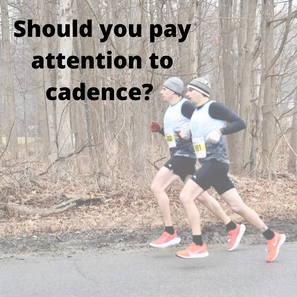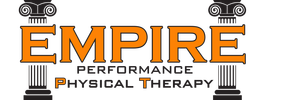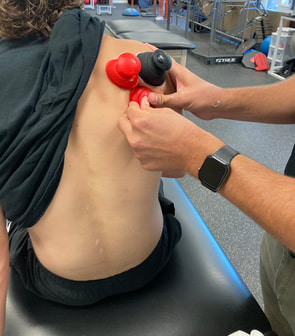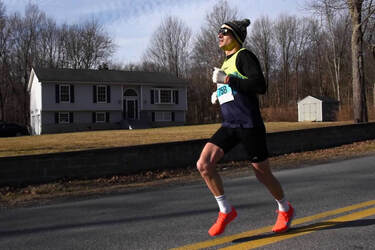|
Cupping is supposed to draw fluid into the area; the discoloration is due to broken blood vessels beneath the skin. This is an ancient Chinese practice where the silicon cup will be applied to reduce skin-pressure by suctioning the air out. As this happens the muscle layer is going to be drawn into the cup and held.
We use Rock pods made by a company called Rock tape. These silicon cups stick to your skin to treat pain, mobility and movement function. Typically used on the neck, back shoulders, hips, thighs, lower legs, and upper arms. When the pods are applied they will use a negative or de compressive pressure. This will help treat chronic pain and relieve tension. Rock pods help treat chronic pain and relieve tension. The cups will bend to your skin and allow you to move with them. Our pods can be moved, and you can slide them to wherever you want! With our pods they can be left on while laying, sitting and even in your movements you do for sports. They can be used in all different ways. Sometimes you’ll see it creates those welts on the skin, that's the negative pressure drawing blood up to the surface. Cupping is usually always used with hands on techniques such as massage during your physical therapy session.
0 Comments
Today Tony talks electrolytes! Patients have been asking Tony what he uses to replenish and what they should be using.
Each person has about 100 sweat glands that are about a quarter the size of your skin which makes you have about a total of 2.6 million sweat glands. The amount of sweat you excrete will depend on gender, fitness level, weather conditions, and altitude. The importance of sweating is to cool your body down. When you work out your body temperature will increase and can rise anywhere up to 3 degrees and that will trigger your body to start sweating. When that happens you'll lose water and electrolytes. What are electrolytes? Electrolytes are substances that have a natural positive or negative electrical charge when dissolved in water. They help your body regulate chemical reactions, maintain the balance between fluids inside and outside your cells! What do electrolytes do? Magnesium, calcium, potassium and sodium are critical to body function. They help balance the amount of water in your body and help maintain body PH levels. How much electrolytes do you need? The amount of electrolytes you will need will vary by person. Tony’s favorite electrolyte supplement is UCAN Hydrate Powder. It comes with a scooper and you just add a little bit to your water! What are the signs of electrolyte imbalance? Signs of electrolyte imbalances can lead to decrease in performance, muscle spasms, weak, dizzy, tired, nauseous, constipated, dry mouth, dry skin,urine and pain. A large majority of muscle cramping can also be due to lack of muscle fitness too. So this could just mean you are overworking your muscles. This is why electrolytes are so important! They regulate and control the balance of fluids in the body. Stay hydrated!! Tony received one question in the clinic and on the website. The question was asking what kind of sneakers he would suggest for walking?! In last week's 5 minute Friday Tony talked about running shoe basics. So that will carry over into this week's episode!
There are a few differences between running shoes and walking shoes. Tony doesn’t see an issue in walking in running shoes, but some people say you shouldn't have that much of a heel toe drop.
Tony recommends these walking shoes:
Running Shoe Basics
Tony wore a different pair of shoes to work this week and got lots of questions on what shoes are good to use for running. So here are 5 tips on what you should consider when buying a pair of running shoes: 1. Shoe Size Shoe size is important because it is very important to wear the correct size shoe. Tony likes to buy his running shoes true to size, but the size you buy is up to your personal preference. You want to make sure your toes have room to spread wide and they shouldn’t feel constricted where they touch the end of your shoe. It is important for your heel to feel comfortably cupped in the back of the shoe too, this will make it so your foot doesn’t slip! Try on different shoes until you find the ones that fit and feel the best! 2. Stack Height Stack height is the amount of shoe material between your foot and the ground. This is expressed in the millimeter height of the heel and just below your toe. A high stack usually is 40 millimeters and has more cushion. Low stack height shoes such as track shoes are about 20 millimeters. Minimal and low stack height shoes are best for people who prefer feeling the ground over the cushioning of a shoe. Highly cushioned shoes are good for someone that prefers feeling the cushioning of a shoe instead of the ground. It depends on whatever you prefer! 3. Heel Toe Drop This is the difference between the level of the heel and level of the toe from the ground. Take one and minus the other and that will give you your heel toe drop. The greater the drop the steeper the angle from the ankle to the forefoot. The lower the drop is considered by many to have a lower impact on the stride. The lower the drop the more the Achilles tendon is going to have to work. The best amount of drop is a personal preference. Anything over 7 is considered a high drop and under that is going to be getting closer to that barefoot feel. Most shoes are at a drop of 6, but it’s up to you what you prefer. Tony sees it all the time when someone comes into the clinic and they just started running or bought a new pair of shoes. They feel like they get a new ache or pain while running and they aren’t sure what happened. This is because shoes have different stack heights so it creates different forces through the leg! 4. Stability or Motion Control Stability running shoes are best for over pronators or if you have more of a flat foot. These shoes are often more rigid and are made to support the arch of the foot, which will provide greater support through the midsole that can also extend into the heel. Stability shoes are something to consider if you get aches and pains! Motion control shoes can be a little stiffer and heavier than a stability shoe. Sometimes motion control shoes have some additional heel cup support and other features in the shoe that stop the foot from rolling when running. Stability and motion control shoes are both great options for runners and should be based on what works best for you! We have a patient that has just started incorporating exercise in their daily routine - they asked our physical therapists when the optimal time is to workout, morning or evening? Tony shares that he personally prefers exercising in the morning.
When determining which is best, morning vs. evening workouts, the most important factor to consider is what will work best for your schedule because the best workout is the one you show up for. However, there are other factors you can consider…. When you hear your alarm go off, sometimes the last thing you want to do is roll out of bed, lace up your sneakers and get to the gym. However, there are some really great advantages to a morning workout! For example, studies show if you plan on doing strength or cardio it requires your body to use stored fat - burn-time will last longer after a morning workout. Also, if you workout or lift in the morning it may result in a better night’s sleep. Additionally, studies show people who workout in the AM have a lower calorie intake compared to those that workout in the evening. With all that said, working out in the evening has its benefits, too. During an evening workout you might perform better and get bigger gains because you’re already warmed up and may be more motivated to workout. You may even have more power and endurance levels! An evening workout could be a great way for you to end your day. After a long day it can be a great way to de-stress and it may result in better sleep. Something you don’t want your workout routine to do is decrease the amount of sleep you get each day - sleep is just as important! Depending on your routine, exercising in the morning may mean waking up earlier than you should. Whereas, exercising in the evening may end up keeping you up. Ultimately, when choosing your workout routine, it should be based on what works best for you! Tony wanted to share his top 5 keys to running. He is an avid runner so he has some great tips! Read below to find out more:
Tony just ran the Pittsburgh marathon this past Sunday - completing the race in two hours and fifty one minutes. Preparing and completing a marathon takes a toll on your body so a good recovery plan is key. Tony is a seasoned marathoner and he has set steps he takes post-marathon - check out his nine step routine below:
Tony has been training for the Pittsburgh marathon and someone asked him how he chooses a goal race. He broke it down into five easy steps...
1. Decide how far you want to race: You can choose any distance race from a 5K to an ultra-marathon. 5K - 3 miles 10K - 6 miles Half Marathon - 13 miles Marathon - 26 miles Ultra Marathon - 50 to 100 miles Triathlons - vary between 16 - 140 miles 2. When do you want to race? AND when do you want to train? When considering what season you want the race to take place (Spring, Summer, fall, Winter) you also need to consider when you want to train. For instance, if you want to do a fall race, your training will take place during the summer. How much training time you’ll need will be discussed in an upcoming step. 3. Where do you want to race? Do you want to race locally or are you looking for a destination race? There are a lot of factors that go into making this decision that should be considered (fees, accommodations, terrain, etc.). To locate races you can use these two resources: runningintheusa.com trifind.com 4. What terrain / conditions do you want the race to be in? This will help determine where you want your race to be held. Think about the terrain that you’re looking for - do you prefer flat runs or do you love running up hills. Flat race, hilly race. Also take into consideration the climate / weather of the place you’re considering - is it typically humid around the time of the race? What will the temperature be? 5. Assess your current fitness level: Your current fitness level will not only determine the length and type of race you’re ready for but it will also help you determine how much training you need to prepare for the race. If you’re a beginner you’re going to need an optimal amount of time to train and prepare. Typically you need: 4-6 months to prepare for a marathon 3-4 months for a Half marathon 8-12 weeks for a 10k 4-8 weeks for a 5  We received a question from one of our patients about running cadence. He’s preparing for his first marathon and so he asked Tony if his running cadence could improve his running speed. Running cadence, or stride rate, is a measure of how many strides per minute (SPM) are made while running. You can find your cadence by counting how many times your right or left foot hits the ground within sixty seconds, then multiply that by two. It’s important to note that cadence changes with different runs. You can’t discuss cadence without considering stride length. The two of these factors come together to determine how fast you’re running. One runner could have a fast cadence with a short stride and another with a slow cadence and long stride and yet they both could be running together. What is a good running cadence? It was widely thought that a rate of 180 SPMs per minute was optimal but that theory has been debunked. Recent studies show that everyone has their own natural running cadence and there is no such thing as a ‘one size fits all’ approach. As you’re running you will naturally find a pace you feel comfortable with but that’s not to say that you can’t improve your cadence (more on that further into this blog). So which is better - a fast or slow cadence? From a Physical therapy stand point, taking shorter and faster steps will make you a more efficient runner and will reduce the impact on your joints. When you take large strides, you’re stretching your legs out further and landing heavily onto your heels (heel strikes). Heel striking vs. midfoot striking is another debate that we will discuss in the future. Shortening your strides can reduce injury risk because you’re not over activating leg muscles and putting too much force through your knees. Is cadence the most important factor for running? As a physical therapist and a running coach, Tony says no. Experts have taken a look at the different cadences of marathon runners and the numbers are all over the place. There have been runners that win with 155 SPM and others that have won with 205 SPM - so a very large range and there isn’t a clear cut number to strive for. In terms of trying to improve overall performance, Tony suggests focusing on the follow metrics:
These metrics will gauge how hard you’re working on your runs. So in terms of improving performance, cadence is not the most important thing and in terms of injury, cadence is something to focus on. Working on your cadence: You can use a metronome, some higher end watches have one built in. Run to music - find songs that have a faster or slower BPM (beats per minute), depending on what you’re looking for. Tips to improve cadence:
A patient slipped and fell while taking out the trash. The fall resulted in a dislocated shoulder. The injury left her unable to move her shoulder for a prolonged period of time - eventually causing frozen shoulder, also known as adhesive capsulitis.
Frozen shoulder is a condition where you experience pain and stiffness in your shoulder joint capsule, eventually losing mobility - hence the name frozen shoulder. Signs and symptoms can occur gradually or within a short period of time. For some people it may happen overnight, for others it will gradually get worse over the course of weeks or even months. Symptoms - you will start experiencing pain in the shoulder and then your range of motion will steadily decrease. You may start to notice that you can’t lift your arm past your shoulder, then eventually not at all. How does it happen? Your bones, ligaments, and tendons that make up your shoulders are encased in what’s called a capsule. Frozen shoulder happens when this capsule thickens and as a result, tightens, causing your shoulder to become immobile. Things that put you at more at risk -
The most common cause of frozen shoulder is shoulder surgery. Most shoulder surgeries cause you to be in a sling for a prolonged period of time. This immobility of your shoulder makes you more susceptible to frozen shoulder. How is frozen shoulder diagnosed? A physical therapy can diagnose frozen shoulder by moving the arm around and documenting the patient's range of motion. Your doctor can use imaging tools such as X-Rays, MRIs, or an ultrasound to rule out other possible causes of the pain and stiffness such as shoulder dislocation, torn rotator cuff or arthritis. Frozen shoulder treatment - Some treatment options include…
Thanks for reading! |
AuthorDr. Tony Tanzi: Physical Therapist, Triathlete, Runner, Performance Coach Archives
October 2022
Categories |





 RSS Feed
RSS Feed